Last weekend I was making my way home. I'd had a couple of pints but nothing too serious and wasn't really paying attention to where I was going. Soon enough, I found the buildings closing in behind me, herding me forward, walling off my escape. And then I heard him.
He came around a corner tall and terrible, a bestial behemoth of pure hate. I nearly retched at the wet dog smell of London after a rain, the unwashed aroma of human bodies and decaying feces and urine. He growled, his voice the sum total of every muttering homeless person, act of defiance and oppression against and by authority, screeching sirens and blasting jackhammers.
"I knew I'd find you eventually," he says. Without warning, his massive fist connects to my mouth and I fall against the ground spitting out the pieces of my front teeth. Every nightmare of losing my teeth comes back, and more as his hoof lands on my shoulder. I hear bones cracking and try futilely to raise my arm.
"Stand and fight me," he says, this living symbol. His legs are made of pound coins mortared by blood and tears, his hands are the muddy Thames sludge built up over thousands of years. A Roman statue and even a piece of my own hair make up his right arm. His rippling body is covered with a vagrant's rags.
"No need to make it worse," the minotaur growls. I nod assent, stand, and his fist flies at me again. I catch it in my hand, and realize I've formed a fist of my own. A token show of self-defense.
It connects with the mirror, glass shatters and I'm left cradling my jaw in the darkness.
Tuesday, September 30, 2008
Sunday, September 28, 2008
Vote The Rock
 It's an interesting time to be an American abroad. The election has been on the forefront of many people's minds over here, and for good reason. While Americans typically couldn't care less (or just don't know about or only vaguely understand) the rest of the world, the rest of the world cares a whole lot about America because its economic and military actions have massive repercussions outside of America. To my American readers that may come as a surprise, and to my European readers it will come as a surprise that it is a surprise to my American readers. But to make a long and somewhat convoluted story short, people here care a great deal about the upcoming American presidential elections and they're very interested to know what us Americans abroad think about it. Conversations about it typically start like this:
It's an interesting time to be an American abroad. The election has been on the forefront of many people's minds over here, and for good reason. While Americans typically couldn't care less (or just don't know about or only vaguely understand) the rest of the world, the rest of the world cares a whole lot about America because its economic and military actions have massive repercussions outside of America. To my American readers that may come as a surprise, and to my European readers it will come as a surprise that it is a surprise to my American readers. But to make a long and somewhat convoluted story short, people here care a great deal about the upcoming American presidential elections and they're very interested to know what us Americans abroad think about it. Conversations about it typically start like this:"So, what do you think of the elections?" This is really a different question. What they mean to ask is "who do you want to win/vote for?"
"Well, things are looking pretty close." This is my way of politely putting them off or making them ask what they really want to ask.
"So who do you want to win?" Translation: "don't make me hit you, tell me if I should continue talking to you or not?"
"Anyone but McCain. I'm behind Obama."
Which is true. There's far more nuance in my answer; I supported Obama from the beginning, but now that the campaign has really started to heat up, I think that Hillary would have made a better president. Actually I always believed that, but I figured (incorrectly, in retrospect) that she probably would have been unelectable. But 'anyone but McCain' is a good answer. 'Anyone but another Republican administration' would be more accurate.
This is the answer people want to hear. Understand American readers that politics outside of the US - anywhere in the world outside of the US - operates from a different perspective. The Tories, the UK's 'Conservative' party, have announced support for Obama. In the UK, Obama would be somewhere to the center or slightly to the right on the political spectrum. Even more so in other European countries. Americans have an incredibly skewed notion of what 'liberalism' means, in no small part because American conservatism has been hijacked and all but destroyed by the radical right. The notion of a vice presidential candidate that is opposed to sex education in public schools or opposes abortion even in cases of rape or incest would be more associated with the fascist (real fascist, mind you) British National Party than a major political party, let alone a major candidate for public office.
It is no mistake that when polled, members of 22 countries wanted Barack Obama to win by a 4 to 1 margin. This is because to the rest of the world, the Republicans and their various beliefs seem more like something out of Iran or third-world African dictatorships than the leaders of a country that can cause such massive repercussions. The UK is nervously eyeing its own economy because it is so intrinsically linked to the American economy, and make no mistake - it was Bush and Neocon-Republican policies that lead to the American economy tottering on the brink. I'm not sure if I'm going to come home to a real-life Mad Max movie when I fly back over Christmas. I'm not sure American Airlines will still be around to fly me home.
So this entire ranty little post grew out of Seth's suggestion that I write about my experiences registering to vote. It's actually really easy to register to vote here, and after watching YouTube videos of Palin like this one:
She is a complete laughingstock, even in the US:
Frankly Palin scares the shit out of me. As Jack Cafferty says, one 72-year-old man's heartbeat away from the presidency? Jesus Christ (this one is the one you want to watch by the way, if you only watch one):
So rather than allow people who think dinosaurs and cavemen lived together to steal yet another election and put someone whose idea of 'foreign policy experience' is taking Track and Bristol to the International House of Pancakes, I registered to vote.
The Overseas Vote Foundation is a nonprofit organization that exists to help US citizens abroad make sure our voices are heard (there are 50,000 Americans here in London alone.) They have automated the entire process; you simply fill out an online form, print it out, pop it in an envelope and mail it off. The biggest obstacle for me was the mailroom at my office. The conversation went like this:
"I'd like to send this letter to the US."
"Is that work-related?"
"Not exactly."
"We can't send personal letters from the mailroom, no way, no how."
"It's my voter registration form. I'm voting for Obama."
"Here, let me stamp it and put it in a basket for you."
I should receive my ballot in a couple of weeks. Easy-peasy. I was actually a little surprised that the State Department is relatively unhelpful about the entire process; so luckily Overseas Vote Foundation has stepped up where the government itself failed.
If you're an American abroad and reading this, register today. Please. Click this link. This link right here. Now. Click. Register. Vote.
Even if you want to vote for that other guy and the pit bull.
Labels:
2008 Election,
government,
registering to vote,
voting
Saturday, September 20, 2008
Friends and the North
I'd be kidding myself if I said that moving to London was easy. The hardest part of any move isn't the logistics, adjusting to a new place, or even the culture shock. It's leaving friends.
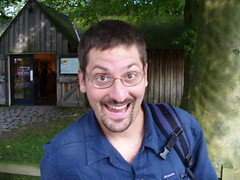
I've known Crabby longer than I've known any of my main circle of friends except for the Beautiful Competition. He was in my wedding and roomed with us in Seattle and he's almost like family to us. He just left after a weeklong visit, having departed the flat at 6 this morning to make it to Gatwick by 7.30, and I'm sitting on the floor typing this not trying to wake anyone up. In another week I'll be making a similar post about Chad, who's currently crashed on our couch.
The travel part of this story is actually pretty funny: last weekend we were supposed to go to Paris, but there was a fire in the Channel Tunnel and our train was canceled. Plane ticket prices went sky high and our options quickly became 'find something in the UK,' so we got cheap train tickets to Yorkshire and went hiking in the North York Moors National Park. It was a great relaxing long weekend away, and while I'm really sad I didn't get to see Paris it was kind of cool hiking around the countryside with Crabby, who is himself quite the outdoorsman and has climbed, among other things, Mt. Adams.
As always, you can find pictures of the trip on my Flickr stream.
We had a great time with Crabby and will no doubt have a great time with Chad, but it threw into very sharp relief for us how much we really miss our lives back in Seattle. We had agreed London was going to be a temporary state of affairs and it's now starting to look more and more like that will definitely be the case, and that we'll return to Seattle when we're done here. My own goals are shifting. My life needs to be about maximizing the time I have here and taking advantage of every opportunity even moreso than before, to enjoy these months and all that London has to offer. Because when I go back to Seattle and we head out to the North Cascades for some camping, or we're sitting around the gaming table or having people over for a Sunday picnic, I want a good story or two to tell when we're spending time with the people we care about most.
(And yes, family readers, that goes for you too!!)

I've known Crabby longer than I've known any of my main circle of friends except for the Beautiful Competition. He was in my wedding and roomed with us in Seattle and he's almost like family to us. He just left after a weeklong visit, having departed the flat at 6 this morning to make it to Gatwick by 7.30, and I'm sitting on the floor typing this not trying to wake anyone up. In another week I'll be making a similar post about Chad, who's currently crashed on our couch.
The travel part of this story is actually pretty funny: last weekend we were supposed to go to Paris, but there was a fire in the Channel Tunnel and our train was canceled. Plane ticket prices went sky high and our options quickly became 'find something in the UK,' so we got cheap train tickets to Yorkshire and went hiking in the North York Moors National Park. It was a great relaxing long weekend away, and while I'm really sad I didn't get to see Paris it was kind of cool hiking around the countryside with Crabby, who is himself quite the outdoorsman and has climbed, among other things, Mt. Adams.
As always, you can find pictures of the trip on my Flickr stream.
We had a great time with Crabby and will no doubt have a great time with Chad, but it threw into very sharp relief for us how much we really miss our lives back in Seattle. We had agreed London was going to be a temporary state of affairs and it's now starting to look more and more like that will definitely be the case, and that we'll return to Seattle when we're done here. My own goals are shifting. My life needs to be about maximizing the time I have here and taking advantage of every opportunity even moreso than before, to enjoy these months and all that London has to offer. Because when I go back to Seattle and we head out to the North Cascades for some camping, or we're sitting around the gaming table or having people over for a Sunday picnic, I want a good story or two to tell when we're spending time with the people we care about most.
(And yes, family readers, that goes for you too!!)
Friday, September 12, 2008
Hadrian!! (Rhymes with Adrian!! from Rocky)
It is an undisputed fact that the British Museum is one of the best museums in the world, not only because it houses pretty much the entire history of the human race under its roof but also because it is absolutely free unless you're going to see a special exhibition. It was just such an exhibition that the Beautiful Competition and I ponied up for last weekend with our pals Simon and Sarah: Hadrian: Empire and Conflict.
It was my first special exhibition at the Museum and was, for the most part, tasteful, educational and interesting. Hadrian was one of the 'good' Roman emperors; he recognized his official responsibilities and left the Empire a better place, helped rebuild Rome (the Pantheon was Hadrian's idea, which served as a model of the Reading Room at the British Museum where the exhibition is held); he pursued a conservative foreign policy building his famous Wall to define the Empire's borders and started abandoning Roman holdings in Dacia and Mesopotamia to consolidate the Empire's power and not overextend it.
Hadrian was also responsible for suppressing the last Jewish revolt in Judea and the creation of the province of Syria-Palestine and the Diaspora that scattered the Jews across the Empire. He had a variety of young male lovers, including one who died by falling in the Nile on a state visit to Egypt. He understood the power of imagery and the most interesting part of the exhibition was the variety of statues depicting Hadrian in a range of different garbs, from warrior to Greek philosopher to god incarnate. It's a wonderful example of ancient public relations and communications and 'brand management': by appearing in a guise that made the most sense to the people in a particular area, Hadrian could be a chameleon whose leadership was accepted in an Empire as multicultural as any today. In that regard, he was brilliant.
The exhibition was interesting but left you feeling a little lacking in content; there was very little in the way of context for most of the exhibit, and although you learn a few interesting tidbits the brilliance of exhibitions like this is that the have the ability to help contextualize history a little more. For example, in the part of the exhibit about the revolt in Judea, I wanted more of the exhibit to contextualize it not only in the history of that time, but in what came before and after in that part of the world. History for me is always a series of relationships that evolve over time, fluid and seamless; it is never isolated events, which is how it was (incorrectly) presented to me in school and how this seemed to present itself.
Hey, it's still worth the money though, especially if you're interested in the period. The model of Hadrian's villa is unbelievably awesome.
It was my first special exhibition at the Museum and was, for the most part, tasteful, educational and interesting. Hadrian was one of the 'good' Roman emperors; he recognized his official responsibilities and left the Empire a better place, helped rebuild Rome (the Pantheon was Hadrian's idea, which served as a model of the Reading Room at the British Museum where the exhibition is held); he pursued a conservative foreign policy building his famous Wall to define the Empire's borders and started abandoning Roman holdings in Dacia and Mesopotamia to consolidate the Empire's power and not overextend it.
Hadrian was also responsible for suppressing the last Jewish revolt in Judea and the creation of the province of Syria-Palestine and the Diaspora that scattered the Jews across the Empire. He had a variety of young male lovers, including one who died by falling in the Nile on a state visit to Egypt. He understood the power of imagery and the most interesting part of the exhibition was the variety of statues depicting Hadrian in a range of different garbs, from warrior to Greek philosopher to god incarnate. It's a wonderful example of ancient public relations and communications and 'brand management': by appearing in a guise that made the most sense to the people in a particular area, Hadrian could be a chameleon whose leadership was accepted in an Empire as multicultural as any today. In that regard, he was brilliant.
The exhibition was interesting but left you feeling a little lacking in content; there was very little in the way of context for most of the exhibit, and although you learn a few interesting tidbits the brilliance of exhibitions like this is that the have the ability to help contextualize history a little more. For example, in the part of the exhibit about the revolt in Judea, I wanted more of the exhibit to contextualize it not only in the history of that time, but in what came before and after in that part of the world. History for me is always a series of relationships that evolve over time, fluid and seamless; it is never isolated events, which is how it was (incorrectly) presented to me in school and how this seemed to present itself.
Hey, it's still worth the money though, especially if you're interested in the period. The model of Hadrian's villa is unbelievably awesome.
Sunday, September 7, 2008
From Hell Chapter Four Walking and Riding Tour
Introduction
Alan Moore and Eddie Campbell's From Hell is one of my favorite pieces of literature. It is many things: a meditation on symbolism, an exploration of Victorian values, a love letter to the city of London, and a close look at how we interpret and extract meaning from history and current events. It's also a damn good story by a damn fine storyteller and a damn fine artist. Eddie Campbell's raw black-and-white illustrations are the perfect images of London to me; they capture the city in a way no photograph or memory ever will.

In Chapter Four, the main character Dr. William Gull and his assistant Netley take a tour through London where Gull explains the city's pagan roots and identity through history, myth and symbol. Before beginning his symbolic 'ritual' Gull himself takes a symbolic journey through London, almost a ritual itself, as a way of connecting with the city and what Gull sees as destiny. He tells Netley 'Our story's written... inked in blood long dry, engraved in [London's] stone.'
This walking (and busing) tour recreates Gull and Netley's journey through London as much as is physically possible so that you too can see the symbolic city and see the stories engraved on London's stones.
Background
This tour is designed to take either one very long day (if you're lucky) or two days if you split the tour up over a weekend. Tourists and London residents alike should find something of interest here. Gull and Netley's route through London has been recreated as closely as is physically possible; some streets run one way the wrong way, some streets are no longer accessible, and some run underground.
You could in theory hire a taxi or drive your own car, but it would either be prohibitively expensive or just plain annoying. There are no more coaches as Netley drove, but London's double-decker buses do offer a decent alternative. When possible, climb to the second floor of the bus and sit at the very front, looking out the front windows. They'll give you an excellent view of the city as you travel and are probably the closest thing to a Victorian coach you can have without dropping an extraordinary amount of money. Like so:
And don't cheat and use the Tube: this tour is designed so you can see the city and get a feel for it in its entirety, including its size and shape. It's impossible to do that underground!
I have tried to make the route as clear as possible, but be aware that street closures, bus route changes, bad weather and other regular London occurrences can and do happen all the time. Before starting out check the Transport for London website. Also highly recommended is your own London A-Z book (available from almost any newsagent) and, of course, a copy of From Hell.
I recommend starting as early in the morning as possible; 6.30 or 7.00 am is not out of the question, especially if you plan to do the entire tour in one day. Because buses run less frequently on Sundays, you're better off doing the tour on a Saturday – or a weekday, if time allows. Be sure to eat a good breakfast:

If you're familiar with London and its bus system, you can probably skip the next part and go right to the tour.
Practical Considerations
In the book, Gull and Netley take the better part of a day to complete their journey. I believe it's possible to do this entire tour in one day, but it's probably very difficult and it is doubtful that you could finish in enough time to get into St. Paul's Cathedral, the final stop on the tour, which admits its last visitors at 4 pm each day. If you truncate the tour slightly by dropping London Fields and Herne's Hill from your itinerary, it would be much more possible to complete in a day (but a little inauthentic.)
In the notes to From Hell, Alan Moore explains that he drove the route in a car and it is 'quite possible to visit all the point of Gull and Netley's journey in a single day.' That may be, but this is designed to be a walking and busing tour so you won't be nearly as mobile. If you need to split up your tour, I suggest doing so around Earl's Court, as this makes an excellent natural dividing point.
In the spirit of full disclosure, I should note that it took me three days to complete the tour but probably could have finished it in two – or even one, if I'd started earlier and hadn't screwed up a couple of parts and been the victim of a massive sewer replacement project that closed down half of Oxford Street. So it goes in London.
London's bus system is plagued with infrequent (or too-frequent) buses, strange routes and rude teenagers blaring horrible hip-hop from low-quality mobile phone speakers. That being said, it's probably one of the best bus systems in the world, covering most of an extremely large and complex city and almost always offering you a method to get from point A to point B with minimal fuss. All bus systems are intimidating at first, but London's can be even more so especially if you're not familiar with it.
Each stop has a list of which buses stop there and where those buses go. Use this to help determine which bus you need to take. Some stops, especially on main thoroughfares and near major intersections, have lists of destinations and which buses take you there. These are accompanied by maps of the area showing you which buses make stops at which locations – stops will often have a white number or letter in a red circle above the sign (for example, XA or R.) I've listed all the routes you'll need for this tour, but if for some reason you need to get somewhere else or a route is diverted or changed, the system is fairly intuitive to use.
The easiest way to get around on the buses is to get an Oyster card (Transport for London's RFID-enabled prepay system) which you simply 'touch in' on a yellow pad each time you board a bus. Either get a weekend pass or a week pass, which will allow you unlimited travel on the bus system (and the Tube.) Don't worry about Tube zones on the bus routes. Otherwise, you'll be on and off the buses enough that you'll spend at least 15 pounds or so, so a weekend pass will save you money. Oyster cards are available at any Underground station and at some newsagents.
To flag down a bus, simply wave at it and try to make eye contact with the driver. To get off, hit the 'stop' button on the rails to request the next stop. If you're unsure where a stop is – and this can be one of the most frustrating parts of riding the bus, especially in an unfamiliar part of town – then ask another passenger or the driver for help. Remember that the drivers can't talk to you when the bus is moving!
London is a big city but it has (statistically speaking, anyway) one of the lowest crime rates of any major metropolitan area. Some of the areas you'll pass through on this tour are lower-income parts of town and can be a little rough around the edges, especially after dark, but none of them are especially dangerous. Still, keep your wits about you and keep your eyes on your belongings, and don't flash things like cameras around unnecessarily.
Also remember that many of Hawksmoor's churches are still active, working religious communities. If you happen to arrive during an event or service, be respectful.
Above all – have fun and enjoy yourself! You're going to see some of the most interesting things in London and get a great cross-section of the city. Now come Netley. Let's to our work.
74 Brook Street
The house of one Dr. William Gull, physician extraordinary to Queen Victoria and the main character in From Hell, is at number 74 Brook Street. The nearest Tube station is Bond Street. From the Tube station (or Oxford Street), head south down Davies Street and take a right on Brook Street; number 74 will be on your right.

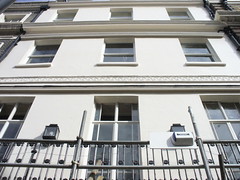
Currently the building suffers from what many historical landmarks in London suffer: scaffolding and reconstruction work. Number 74 will be under wraps until 2009 (according to the work order posted out front), but it still makes a good start to the tour so you can get a feel for the still well-to-do area from which Gull and Netley began.
In From Hell, Gull is Jack the Ripper, who commits the Ripper crimes because he's trying to complete a ritual that will take away the rising power of women (for the complete explanation, read the book.) The theory comes from a book called Jack the Ripper: The Final Solution by Stephen Knight. Alan Moore states that he doesn't believe Gull was the Ripper, although it does make for a good story.
Historically Gull was a gifted physician who described the condition now known as hyperthyroidism. His entire biography, published in 1896, is available online.
Number 74 is on a quiet street in Mayfair, one of the most expensive places to live in the world (it is the most expensive property on the British version of Monopoly as well.) It contrasts well with many of the low-income areas Gull and Netley traversed on their tour, many of which have not changed much in the last 110 years.
Before you leave, check out houses # 23 and 25 just down the road, where Jimi Hendrix and George Handel lived (although not at the same time.)
Return to Oxford Street via Davies Street and catch the Number 8 bus to Chancery Lane. The bus stop is right in front of House of Fraser, a quick walk down Oxford Street. Change at Chancery Lane Tube, walking up Gray's Inn Road to catch the Number 17 or 45 which takes you to King's Cross station (the 45 actually terminates there, so it's the last stop on the bus.) Walk in front of the station to Pancras Road on the west side, turn right and walk past St. Pancras Station. You'll come to:
Battle Bridge Road
Battle Bridge Road is the legendary location of the battle between Queen Boudica of the Iceni and the occupying Roman forces where Boudica's army was annihilated and the Queen herself killed, following her revolt against the Romans and her subsequent burning of Londinium to the ground (not the last time that would happen.) There is no real historical evidence for this, nor is there any evidence to support another myth that Boudica is buried beneath platform 9 or 10 at King's Cross Station. It also happens to be the location for Harry Potter's Platform 9 ¾.
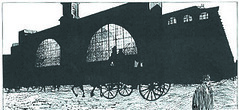
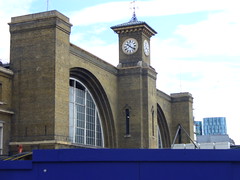
Battle Bridge Road is currently behind a locked gate and due to be buried under the expanded King's Cross Station, so if you're lucky enough to get a look, enjoy it while you can. I had to confirm with a Black Cab driver waiting in the queue for King's Cross Station that it was, in fact, Battle Bridge Road. His response: 'it used to be.' The last of the Victorian slums that Gull remarked upon is still visible a short walk to the north, past the giant rusting petroleum tank. Note progress and expansion and the way it is burying historical pieces of London, just as it has done for centuries. Instead of fires and bombs, this time it's pure economics, a force that can be just as destructive.
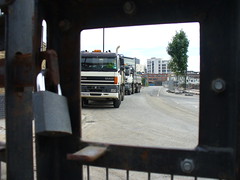

When you're ready to move on, head back to the station and walk to Pentonville Road. From here, catch bus 73 or bus 476 to Ball's Pond Road, where you'll switch (check the stop maps – it will tell you where to go) to bus 277 or bus 38. Take this bus to the Greenwood Road stop (you might have to ask someone where this is, or pay attention), cross Graham Road and walk down Greenwood Road to reach:
London Fields, Hackney
Today, London Fields is a park in the middle of Hackney. In Gull's time, it was still used as pastureland by some of the poor in the slums around Hackney, although it is worth noting that cricket has been played here since 1802. It was originally used as a pasture as early as 1540 (or earlier, but 1540 is the first recorded use under this name.)

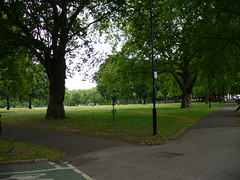
As Gull notes, Hackney was once Hakons Ea (or Haca's ey, meaning 'marshland'), a Saxon settlement. The settlement was not located at the Fields, however. There are some hills on the south side of the Fields that are clearly manmade though, so imagine them to be Saxon burial grounds or fortifications if you want. I did.

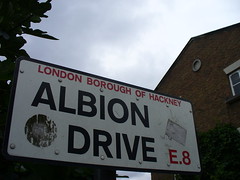
Walk south through London Fields and take the southwestern exit. Cross Landsdowne Drive to Shrubland Road and bear right to see Albion Drive, upon which Gull and Netley stopped (although now it is not in view of the Fields, as it may have been in Victorian times.) Then go back to Landsdowne Drive and walk south around the Fields to Broadway. There's a fun market here on Saturdays if you happen to come through at that time; it's an interesting shopping street on other days as well. Walk south on Broadway to Goldsmith's Row, crossing Regent's Canal, and walk all the way to Hackney Road. Cross Hackney Road and take a left, catching the number 55 bus at the Warner Place stop. Take this all the way to Old Street Station. You'll be walking for a while from here. Once off the bus, walk south on City Road until you come to:
Bunhill Fields and Blake's Grave
Bunhill Fields was once called Bone Hill Fields, the name originating from its use as a burial site since Saxon times. It contains many notable graves but nowadays is also a hangout for drug dealers and kids from the surrounding council estates. Blake's grave is the small one about halfway through in the shadow of the obelisk from Daniel Defoe's memorial. The position of the graves in From Hell isn't quite accurate, but I can fully understand Eddie Campbell's artistic license in rotating Blake's grave a bit. Blake's memorial is typically covered with change (leave some if you'd like), strangely untouched by the locals.
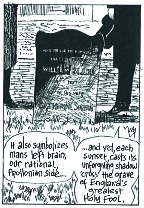
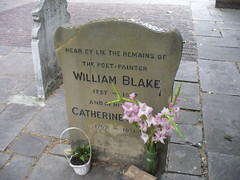
Gull notes that Blake was a 'prophet' and 'a throwback from beyond the Age of Reason, from a time of magic thinking when the Gods yet walked with men.' I'm no Blake scholar and I leave the details of his work to those who have studied him far more than I, but this quiet section of London does make for a good area in which to take a few moments and reflect on an age of magic now disappeared. The power here is almost palpable.
When you're done, walk through the cemetery to the other exit and turn right to go back to Old Street, then hang a left and keep walking. You'll see its steeple before you get there, and believe me when you see it you'll understand why Gull makes such a big deal of the obelisk on top of:

St. Luke's Old Street
St. Luke's is the first of Nicholas Hawksmoor's churches we'll visit on this tour, although note that Hawksmoor only designed the tower and its awesome obelisk steeple. Like many others it was heavily damaged during the Blitz but recently reopened after renovations and is apparently a popular spot for concerts. The church will likely be locked when you arrive but the churchyard is open, allowing you to walk around and get a taste of this unique church.

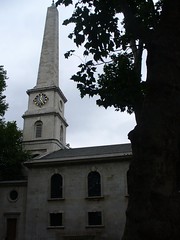
Hawksmoor's white stone churches are striking in their starkness compared with the typically dull surroundings of London, even moreso on a cloudy English day when they still manage to be bright as though lit from an unseen source.
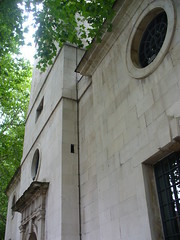
The obelisk steeple is remarkable and remarkably intact. It's a nice contrast to the next Hawksmoor church on our list, so keep it in mind. When you're finished, head back to Old Street and walk to Goswell Road. Take a right, then a left on Sebastian Street to:
Northampton Square
There isn't much to see here. The Masons play a major (fictional) role in From Hell, but nowadays it's just a typical mix of flats and small businesses.
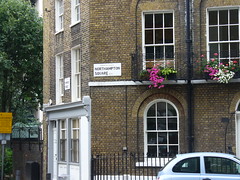
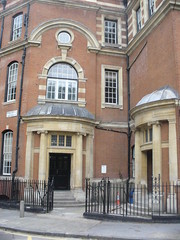
When you've had your fill, walk through the square to the southwest exit and leave via Wycliff Street. Take a left when you get to St. John Street, which takes you back to Old Street, which turns into Clerkenwell right around here. You can walk this next part or catch the number 55 bus. If you catch the bus, get off before Southampton, walk north on Southampton and turn left on Vernon Place (it's Theobald's Road on the right side of the intersection), cross to the north side of the street and walk to:
St. George's Bloomsbury
Where St. Luke's has a massive sun god's symbol as a steeple, St. George's Bloomsbury is a Greek temple uprooted and planted firmly in the middle of London. The tower was modeled after the Mausoleum at Halicarnassus, and the front based on the Temple of Bacchus in Baalbek, Lebanon. The church is in a fairly poor state of repair on the outside (but better than it was, if you read Moore's notes in the appendix to From Hell.)
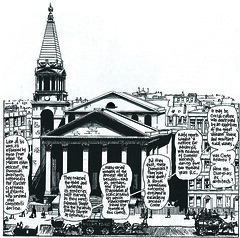

The massive columns are something completely out of time. You may be able to get into the church for a tour – there was a wedding going on when I was there – and note that the crypt is currently To Let if you're interested in starting a business in a church's graveyard.
When you're done enjoying St. George's Bloomsbury, walk down Bloomsbury Way where it turns into New Oxford Street, cross Tottenham Court Road and catch your old friend the 55 bus to Oxford Circus. Switch to the #10 bus to Kensington High Street – ride it past the V&A and get off when you reach:
Earl's Court
Earl's Court is a fairly large section of town, but the main drag is Earl's Court Road. You'll pass most of the tourist hotels on the way here, and Earl's Court Road today is a bunch of Chinese and Indian restaurants of dubious quality with a smattering of decent to 'meh' pubs. If you want a lunch of Pie (as Gull and Netley ate – although Kidney Pie is a rarity these days), the Blackbird Pub should have one for you.

Earl's Court was once Billingswell, as Gull notes, or 'Belinos' Well' after the sun god-King Belinos, son of King Lud. Lud himself is named later in Ludgate, just outside of St. Paul's Cathedral – the pagan origins of many of London's areas are still there, if a little tarnished by modernism and the passage of time.
It's also worth noting that the Lord Ranelagh Pub in Earl's Court had one of London's first 'public' drag queen shows in the early 1960s, and is considered to have played a role in gay liberation in the UK.
Once you've seen Earl's Court and had a nice lunch, grab the C1 bus anywhere along Earl's Court Road and ride it to Victoria Bus Station. Switch at Victoria to the #11 bus; take it through Victoria and get off at Southampton Road. Cross the street, where you'll see a passthrough to Victoria Embankment (look for the sign.) Walk down this street and through a tiny park; there's a Zebra crossing about 20 meters to your right that literally drops you in front of:
Cleopatra's Needle
Another landmark covered in scaffolding, another sun god's symbol. Its twins are in Paris and in Central Park in New York, but they came from Heliopolis during the reign of Thutmose III around 1450 BC, making them about 3500 years old.

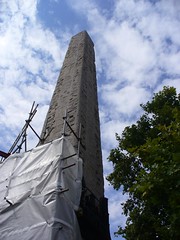

It actually has nothing to do with Cleopatra and you can read the story of bringing the Needle to London on the plaques on the base, or in From Hell. For being 3500 years old it's in a remarkable state of repair. Check out the steps leading directly into the Thames, which must have seemed like a great idea on paper but tend to catch all kinds of horrible floatsam.
When you've had your fill, cross the street and walk along the Embankment to Waterloo Bridge. Look for the steps up on your left, then cross the bridge (on the east side, your left as you're crossing the river.)
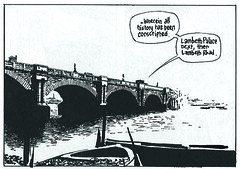
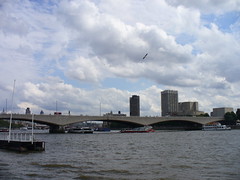
Near the end of the bridge, you'll catch the #1 bus to Elephant & Castle. At the same stop or the one about 15 meters away, catch the 68 or 468 towards Herne Hill – the stop you want is Brockwell Park, after you come down Herne Hill proper. You'll pass through Brixton, synonymous with London's hip-hop scene, and into the far more suburban areas of Herne Hill. You'll almost think you're in Kent, because crowded flats give way to houses with front yards.
Note this route deviates a bit from Gull and Netley's route (it doesn't pass Bedlam or Lambeth Palace, or Hercules Road), only because there is no bus that travels that way that goes anywhere near where we want to end up and it would literally take hours to walk.
Once off the bus take in:
Herne Hill
Herne Hill is named for Herne, a horned god who lead the wild hunt, known in many Celtic and Neolithic cultures. Herne is actually a ghost in Windsor Forest, mentioned in Shakespeare's Merry Wives of Windsor, who may have been a historical huntsman who worked for Richard II; connecting Herne to the Horned God is a fairly recent development and seems to only have been done in Victorian times.
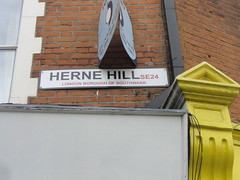
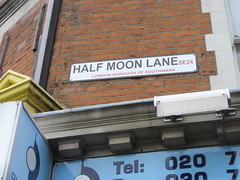
The corner of Herne Hill Road and Half Moon Lane looks much as it does in the book, and the building to the left of the bridge on page 24 of Chapter 4 is the Half Moon Pub, a good place for a pint if you're starting to feel thirsty.

Feel free to take a walk through the park if you have the time, otherwise go to Half Moon Road across the street from the pub and catch the #37 bus to Peckham. Switch to the #78 bus at Hanover Park (in front of a giant Morrisons.) Ride the #78 all the way to Tower Bridge Road, getting off at Druid Street. Walk a few meters further down Tower Bridge Road and on your left will be:
St. John's Horsleydown
Which isn't a church anymore at all, but is now the London City Mission building. Only the base of St. John's survives, which is a shame since the only part of it that was Hawksmoor's was the steeple, which was destroyed during the Blitz. You can walk around the base and see how it was integrated into the office building that now sits on top of it, and still make out some of the memorial stones embedded in it and the gravestones that have been stacked up on the far side of the churchyard.


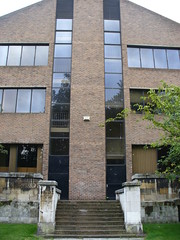
When you're done, go back to Tower Bridge Road and walk towards the Thames, turning left on Tooley Street. You'll be on foot for a while again. Walk down to London Bridge and take a right, walking across the bride and taking in the excellent views of the Tower and Tower Bridge.

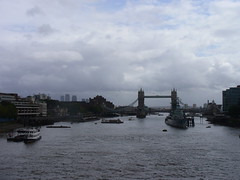
On the far side, bear right around the outside of Monument station brings you face to face with:
Monument
Another obelisk. It will be under repairs until mid-2009 at least, so you probably won't get to see much that isn't covered in curtains and scaffolding. The Monument was designed by Christopher Wren to commemorate the Great Fire of London in 1666, which started just a few meters away. Sadly the view that Gull and Netley had in From Hell is now blocked by office buildings, so you'll have to take it in from street level.
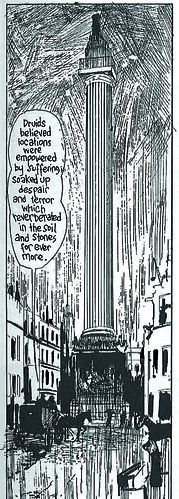
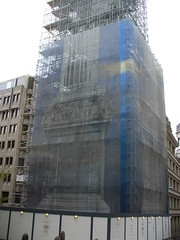
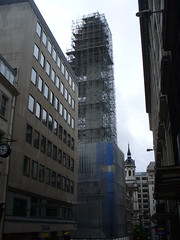
Just north of the Monument catch Eastcheap street going east and walk towards the thing that every tourist in the world will be around:
Tower of London
The Tower was originally built – or at least part of it was – by William the Conqueror in 1078. Conquering Bill used it as a palace and fortress when London desperately needed both, but after the advent of artillery and the overcrowded city the royalty moved on, leaving the Tower more for administrative purposes (and prison purposes.)


Nowadays it is the single-most-expensive tourist destination in London; if you've never been inside it's worth a trip, but make a day out of it rather than trying to squeeze it into this tour. That way you'll get your money's worth at least. Note the large section of Roman wall just outside of Tower Hill station as you walk along the north part of the Tower, then bend around the north side of a junction of streets making for East Smithfield Street. This eventually turns into The Highway (Ratcliff Highway to Gull and Netley) where pirates were hanged (and, until the turn of the last century, was the part of Wapping notorious for brothels and rough pubs.)

Continue along past the Mint until you get to the redundantly-named Cannon Street Road.

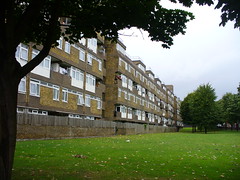
Your object is right in front of you, the shell of:
St. George's In The East
A direct hit with a bomb during the Blitz destroyed the interior of this Hawksmoor church, leaving only the shell. It's an impressive structure from the outside, and if Hawksmoor's plans had been followed it might have been the greatest of his churches. The turrets look like something out of an H.P. Lovecraft story, alien and almost sinister. You can walk through the churchyard and get a taste of what the church looks like from several angles; if the doors are open, check out the interior, a 1960s brick building – almost like a church-within-a-church, which is basically what it is. The contrast is extraordinary.

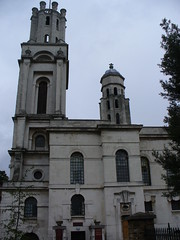
After you're finished, turn right up Cannon Street Road and continue until you reach Commercial Street. On Commercial, turn right and walk a short distance to the next bus stop where you can catch the 15, 115 or 135 to Limehouse Town Hall. Cross Commercial and turn down Newell Street. The entrance you're looking for is just past the rectory on your left, where you'll see through the gates:
St. Anne's Limehouse
Another glorious Hawksmoor church. The churchyard here contains some very interesting graves. The giant pyramid here was originally supposed to be placed on top of the tower, another of Hawksmoor's pagan-inspired ideas. Definitely check out the cool cupola over the door which looks vaguely like a small Doric temple.



You can walk around and get a good taste for the church from several different angles. The trees obscure most of the views of the full building, but it's an enjoyable quiet area all the same. Note how the busy traffic on Commercial seems to fade into the background here.
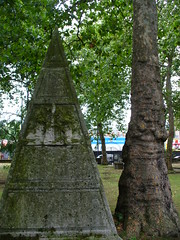
When you're done, head back to Commercial and grab the #15 bus at the stop right outside the locked churchyard gate. Take it all the way to Liverpool Street Station. Cross Bishopsgate and head north (left) to Brushfield Street on your right – there's a massive glass office on your left and coffee houses on your right. Your next destination is right in front of you. Walk past Spitalfields Market and all the little shops (or better yet, stop and enjoy some of them – there are some great little shops in this part of town.) Then continue on to:
Christ Church, Spitalfields
This is the church that features so prominently in the story, partly because the Ripper's victims were all found in Whitechapel in the streets around here. Christ Church should be open, so feel free to step inside and have a look around.
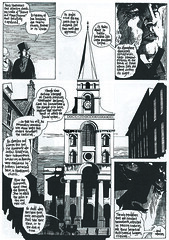
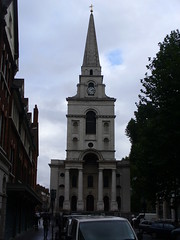
In the last 10 years the church has undergone some major restoration work to Hawksmoor's original plans – even before the Blitz it had been heavily modified and had fallen into terrible disrepair – so its interior probably looks as close to Hawksmoor's original designs as can be achieved. Parts of it are still in pieces, but the views from the balconies are worth climbing up the stairs for. They also let you take pictures inside (unlike some other churches – I'm looking at you, St. Paul's Cathedral!) and they have some good (free) pamphlets about Hawksmoor if you're interested.
You're almost done, and you might be feeling a bit parched at this point, so why not stop in the pub across the street – the Ten Bells. This is the pub where the Ripper's victims drank (both historically and in the book), and it looks as though it hasn't been maintained since those times. In actuality, most of the interior is new except for the decorative tiling, which is straight out of the Ripper's time.
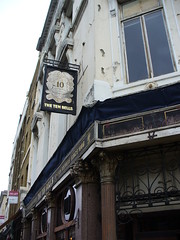
The topless dancers from Alan Moore's notes are gone now, replaced by the no-longer-illicit thrill of drinking absinthe and a variety of lagers. You can also get a latte here now, a sign of changing times if there ever was one. Be sure to make a stop in the bathroom; note the mounted vintage newspapers about the Ripper on the way down and marvel at the sheer amount of graffiti on the walls. Leave your own personal note if you want, they don't seem to mind.
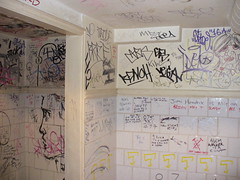
When you're done, return to Bishopsgate and head south. Turn right on Cornhill and walk to Bank tube station; take advantage of the underpass so you don't have to dodge traffic and follow the signs of Poultry or Cheapside. Emerge, take Poultry until it turns into Cheapside and keep walking until you see a massive dome on your left that belongs to:
St. Paul's Cathedral
The last stop on our tour. If it's before 4.00 pm you can get in and walk around, but be aware that it costs 10 pounds and you can't take pictures. St. Paul's is well worth a visit but you might be a little tired to climb the three-hundred-some steps to the top of the dome (and some of the best views in London). It's interesting to note how many iterations Wren's designs went through before they settled on this one; it's also worth looking at the pictures of the previous Gothic cathedral, which replaced the Saxon one on the same site. The Gothic building's spire must have been massive.


The Solomon's Stone that Gull shows Netley is just as Moore describes it, in the far right-hand corner of the Cathedral on the right just after you walk in. It's not recessed in a niche as Eddie Campbell drew it, but is just mounted on a plaque on the wall and looks suspiciously unlike an actual stone from the Temple of Solomon – but hey, it's cool anyway.
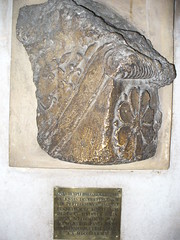
There should be chairs set up around the great design under the dome where Gull and Netley mapped out their journey, and you can go back and mark points on your A-Z if you want roughly where they did. Looking up at the domes, you can almost imagine the chains there, still chaining the gods to London:
You can marvel at one of the greatest Renaissance buildings in the world, one of the few European Cathedrals build by Protestants instead of Catholics, and an amazing and heavy piece of architecture. If you've been in a Gothic cathedral, note how different the Baroque building feels in terms of strength instead of grace; a completely different kind of grandeur.
And congratulate yourself, because you just followed Gull and Netley's path around London! If you were marking your A-Z check to see if you made a pentagram. You'll find it's pretty darn close to the illustrations at the end of Chapter Four.
As you went I hope you remembered to look for the stories engraved in stone. A pagan place barely tamed; an ancient city a victim of entropy, covered in scaffolding to stave off the wear of time; Victorian slums once inhabited by immigrants knocked down and replaced with council estates inhabited by subsequent waves of immigrants just as Whitechapel was in Gull's time; peeling paint and trees growing from roofs followed by multimillion-pound mansions.
That is London: the city is the story, a much-told tale that continues to unfurl in the lives of millions of people just as it has every day since it was founded two thousand years ago. Gull's London, Netley's London, Moore's London, Campbell's London, the Ripper's London, his victims' London, my London, your London. Make your own mark upon the stone, because it's a story shared by all.
I hope you enjoyed the tour, and if you walked and rode it I'd love to hear what you thought. I intentionally didn't create maps to go along with the tour partially because it's very easy to find everything and follow directions, and partially because part of the magic of this tour is to mark your own maps in your own ways and check off your points at the end. If you find that anything major has changed in the directions, let me know and I'll update the post above.
Like this post? Digg It.
Want to see all the pictures with further commentary? They're on Flickr.
Note: Images from From Hell used for research and comparison purposes only.
Alan Moore and Eddie Campbell's From Hell is one of my favorite pieces of literature. It is many things: a meditation on symbolism, an exploration of Victorian values, a love letter to the city of London, and a close look at how we interpret and extract meaning from history and current events. It's also a damn good story by a damn fine storyteller and a damn fine artist. Eddie Campbell's raw black-and-white illustrations are the perfect images of London to me; they capture the city in a way no photograph or memory ever will.

In Chapter Four, the main character Dr. William Gull and his assistant Netley take a tour through London where Gull explains the city's pagan roots and identity through history, myth and symbol. Before beginning his symbolic 'ritual' Gull himself takes a symbolic journey through London, almost a ritual itself, as a way of connecting with the city and what Gull sees as destiny. He tells Netley 'Our story's written... inked in blood long dry, engraved in [London's] stone.'
This walking (and busing) tour recreates Gull and Netley's journey through London as much as is physically possible so that you too can see the symbolic city and see the stories engraved on London's stones.
Background
This tour is designed to take either one very long day (if you're lucky) or two days if you split the tour up over a weekend. Tourists and London residents alike should find something of interest here. Gull and Netley's route through London has been recreated as closely as is physically possible; some streets run one way the wrong way, some streets are no longer accessible, and some run underground.
You could in theory hire a taxi or drive your own car, but it would either be prohibitively expensive or just plain annoying. There are no more coaches as Netley drove, but London's double-decker buses do offer a decent alternative. When possible, climb to the second floor of the bus and sit at the very front, looking out the front windows. They'll give you an excellent view of the city as you travel and are probably the closest thing to a Victorian coach you can have without dropping an extraordinary amount of money. Like so:
And don't cheat and use the Tube: this tour is designed so you can see the city and get a feel for it in its entirety, including its size and shape. It's impossible to do that underground!
I have tried to make the route as clear as possible, but be aware that street closures, bus route changes, bad weather and other regular London occurrences can and do happen all the time. Before starting out check the Transport for London website. Also highly recommended is your own London A-Z book (available from almost any newsagent) and, of course, a copy of From Hell.
I recommend starting as early in the morning as possible; 6.30 or 7.00 am is not out of the question, especially if you plan to do the entire tour in one day. Because buses run less frequently on Sundays, you're better off doing the tour on a Saturday – or a weekday, if time allows. Be sure to eat a good breakfast:

If you're familiar with London and its bus system, you can probably skip the next part and go right to the tour.
Practical Considerations
In the book, Gull and Netley take the better part of a day to complete their journey. I believe it's possible to do this entire tour in one day, but it's probably very difficult and it is doubtful that you could finish in enough time to get into St. Paul's Cathedral, the final stop on the tour, which admits its last visitors at 4 pm each day. If you truncate the tour slightly by dropping London Fields and Herne's Hill from your itinerary, it would be much more possible to complete in a day (but a little inauthentic.)
In the notes to From Hell, Alan Moore explains that he drove the route in a car and it is 'quite possible to visit all the point of Gull and Netley's journey in a single day.' That may be, but this is designed to be a walking and busing tour so you won't be nearly as mobile. If you need to split up your tour, I suggest doing so around Earl's Court, as this makes an excellent natural dividing point.
In the spirit of full disclosure, I should note that it took me three days to complete the tour but probably could have finished it in two – or even one, if I'd started earlier and hadn't screwed up a couple of parts and been the victim of a massive sewer replacement project that closed down half of Oxford Street. So it goes in London.
London's bus system is plagued with infrequent (or too-frequent) buses, strange routes and rude teenagers blaring horrible hip-hop from low-quality mobile phone speakers. That being said, it's probably one of the best bus systems in the world, covering most of an extremely large and complex city and almost always offering you a method to get from point A to point B with minimal fuss. All bus systems are intimidating at first, but London's can be even more so especially if you're not familiar with it.
Each stop has a list of which buses stop there and where those buses go. Use this to help determine which bus you need to take. Some stops, especially on main thoroughfares and near major intersections, have lists of destinations and which buses take you there. These are accompanied by maps of the area showing you which buses make stops at which locations – stops will often have a white number or letter in a red circle above the sign (for example, XA or R.) I've listed all the routes you'll need for this tour, but if for some reason you need to get somewhere else or a route is diverted or changed, the system is fairly intuitive to use.
The easiest way to get around on the buses is to get an Oyster card (Transport for London's RFID-enabled prepay system) which you simply 'touch in' on a yellow pad each time you board a bus. Either get a weekend pass or a week pass, which will allow you unlimited travel on the bus system (and the Tube.) Don't worry about Tube zones on the bus routes. Otherwise, you'll be on and off the buses enough that you'll spend at least 15 pounds or so, so a weekend pass will save you money. Oyster cards are available at any Underground station and at some newsagents.
To flag down a bus, simply wave at it and try to make eye contact with the driver. To get off, hit the 'stop' button on the rails to request the next stop. If you're unsure where a stop is – and this can be one of the most frustrating parts of riding the bus, especially in an unfamiliar part of town – then ask another passenger or the driver for help. Remember that the drivers can't talk to you when the bus is moving!
London is a big city but it has (statistically speaking, anyway) one of the lowest crime rates of any major metropolitan area. Some of the areas you'll pass through on this tour are lower-income parts of town and can be a little rough around the edges, especially after dark, but none of them are especially dangerous. Still, keep your wits about you and keep your eyes on your belongings, and don't flash things like cameras around unnecessarily.
Also remember that many of Hawksmoor's churches are still active, working religious communities. If you happen to arrive during an event or service, be respectful.
Above all – have fun and enjoy yourself! You're going to see some of the most interesting things in London and get a great cross-section of the city. Now come Netley. Let's to our work.
74 Brook Street
The house of one Dr. William Gull, physician extraordinary to Queen Victoria and the main character in From Hell, is at number 74 Brook Street. The nearest Tube station is Bond Street. From the Tube station (or Oxford Street), head south down Davies Street and take a right on Brook Street; number 74 will be on your right.


Currently the building suffers from what many historical landmarks in London suffer: scaffolding and reconstruction work. Number 74 will be under wraps until 2009 (according to the work order posted out front), but it still makes a good start to the tour so you can get a feel for the still well-to-do area from which Gull and Netley began.
In From Hell, Gull is Jack the Ripper, who commits the Ripper crimes because he's trying to complete a ritual that will take away the rising power of women (for the complete explanation, read the book.) The theory comes from a book called Jack the Ripper: The Final Solution by Stephen Knight. Alan Moore states that he doesn't believe Gull was the Ripper, although it does make for a good story.
Historically Gull was a gifted physician who described the condition now known as hyperthyroidism. His entire biography, published in 1896, is available online.
Number 74 is on a quiet street in Mayfair, one of the most expensive places to live in the world (it is the most expensive property on the British version of Monopoly as well.) It contrasts well with many of the low-income areas Gull and Netley traversed on their tour, many of which have not changed much in the last 110 years.
Before you leave, check out houses # 23 and 25 just down the road, where Jimi Hendrix and George Handel lived (although not at the same time.)
Return to Oxford Street via Davies Street and catch the Number 8 bus to Chancery Lane. The bus stop is right in front of House of Fraser, a quick walk down Oxford Street. Change at Chancery Lane Tube, walking up Gray's Inn Road to catch the Number 17 or 45 which takes you to King's Cross station (the 45 actually terminates there, so it's the last stop on the bus.) Walk in front of the station to Pancras Road on the west side, turn right and walk past St. Pancras Station. You'll come to:
Battle Bridge Road
Battle Bridge Road is the legendary location of the battle between Queen Boudica of the Iceni and the occupying Roman forces where Boudica's army was annihilated and the Queen herself killed, following her revolt against the Romans and her subsequent burning of Londinium to the ground (not the last time that would happen.) There is no real historical evidence for this, nor is there any evidence to support another myth that Boudica is buried beneath platform 9 or 10 at King's Cross Station. It also happens to be the location for Harry Potter's Platform 9 ¾.


Battle Bridge Road is currently behind a locked gate and due to be buried under the expanded King's Cross Station, so if you're lucky enough to get a look, enjoy it while you can. I had to confirm with a Black Cab driver waiting in the queue for King's Cross Station that it was, in fact, Battle Bridge Road. His response: 'it used to be.' The last of the Victorian slums that Gull remarked upon is still visible a short walk to the north, past the giant rusting petroleum tank. Note progress and expansion and the way it is burying historical pieces of London, just as it has done for centuries. Instead of fires and bombs, this time it's pure economics, a force that can be just as destructive.


When you're ready to move on, head back to the station and walk to Pentonville Road. From here, catch bus 73 or bus 476 to Ball's Pond Road, where you'll switch (check the stop maps – it will tell you where to go) to bus 277 or bus 38. Take this bus to the Greenwood Road stop (you might have to ask someone where this is, or pay attention), cross Graham Road and walk down Greenwood Road to reach:
London Fields, Hackney
Today, London Fields is a park in the middle of Hackney. In Gull's time, it was still used as pastureland by some of the poor in the slums around Hackney, although it is worth noting that cricket has been played here since 1802. It was originally used as a pasture as early as 1540 (or earlier, but 1540 is the first recorded use under this name.)


As Gull notes, Hackney was once Hakons Ea (or Haca's ey, meaning 'marshland'), a Saxon settlement. The settlement was not located at the Fields, however. There are some hills on the south side of the Fields that are clearly manmade though, so imagine them to be Saxon burial grounds or fortifications if you want. I did.


Walk south through London Fields and take the southwestern exit. Cross Landsdowne Drive to Shrubland Road and bear right to see Albion Drive, upon which Gull and Netley stopped (although now it is not in view of the Fields, as it may have been in Victorian times.) Then go back to Landsdowne Drive and walk south around the Fields to Broadway. There's a fun market here on Saturdays if you happen to come through at that time; it's an interesting shopping street on other days as well. Walk south on Broadway to Goldsmith's Row, crossing Regent's Canal, and walk all the way to Hackney Road. Cross Hackney Road and take a left, catching the number 55 bus at the Warner Place stop. Take this all the way to Old Street Station. You'll be walking for a while from here. Once off the bus, walk south on City Road until you come to:
Bunhill Fields and Blake's Grave
Bunhill Fields was once called Bone Hill Fields, the name originating from its use as a burial site since Saxon times. It contains many notable graves but nowadays is also a hangout for drug dealers and kids from the surrounding council estates. Blake's grave is the small one about halfway through in the shadow of the obelisk from Daniel Defoe's memorial. The position of the graves in From Hell isn't quite accurate, but I can fully understand Eddie Campbell's artistic license in rotating Blake's grave a bit. Blake's memorial is typically covered with change (leave some if you'd like), strangely untouched by the locals.


Gull notes that Blake was a 'prophet' and 'a throwback from beyond the Age of Reason, from a time of magic thinking when the Gods yet walked with men.' I'm no Blake scholar and I leave the details of his work to those who have studied him far more than I, but this quiet section of London does make for a good area in which to take a few moments and reflect on an age of magic now disappeared. The power here is almost palpable.
When you're done, walk through the cemetery to the other exit and turn right to go back to Old Street, then hang a left and keep walking. You'll see its steeple before you get there, and believe me when you see it you'll understand why Gull makes such a big deal of the obelisk on top of:

St. Luke's Old Street
St. Luke's is the first of Nicholas Hawksmoor's churches we'll visit on this tour, although note that Hawksmoor only designed the tower and its awesome obelisk steeple. Like many others it was heavily damaged during the Blitz but recently reopened after renovations and is apparently a popular spot for concerts. The church will likely be locked when you arrive but the churchyard is open, allowing you to walk around and get a taste of this unique church.


Hawksmoor's white stone churches are striking in their starkness compared with the typically dull surroundings of London, even moreso on a cloudy English day when they still manage to be bright as though lit from an unseen source.

The obelisk steeple is remarkable and remarkably intact. It's a nice contrast to the next Hawksmoor church on our list, so keep it in mind. When you're finished, head back to Old Street and walk to Goswell Road. Take a right, then a left on Sebastian Street to:
Northampton Square
There isn't much to see here. The Masons play a major (fictional) role in From Hell, but nowadays it's just a typical mix of flats and small businesses.


When you've had your fill, walk through the square to the southwest exit and leave via Wycliff Street. Take a left when you get to St. John Street, which takes you back to Old Street, which turns into Clerkenwell right around here. You can walk this next part or catch the number 55 bus. If you catch the bus, get off before Southampton, walk north on Southampton and turn left on Vernon Place (it's Theobald's Road on the right side of the intersection), cross to the north side of the street and walk to:
St. George's Bloomsbury
Where St. Luke's has a massive sun god's symbol as a steeple, St. George's Bloomsbury is a Greek temple uprooted and planted firmly in the middle of London. The tower was modeled after the Mausoleum at Halicarnassus, and the front based on the Temple of Bacchus in Baalbek, Lebanon. The church is in a fairly poor state of repair on the outside (but better than it was, if you read Moore's notes in the appendix to From Hell.)


The massive columns are something completely out of time. You may be able to get into the church for a tour – there was a wedding going on when I was there – and note that the crypt is currently To Let if you're interested in starting a business in a church's graveyard.
When you're done enjoying St. George's Bloomsbury, walk down Bloomsbury Way where it turns into New Oxford Street, cross Tottenham Court Road and catch your old friend the 55 bus to Oxford Circus. Switch to the #10 bus to Kensington High Street – ride it past the V&A and get off when you reach:
Earl's Court
Earl's Court is a fairly large section of town, but the main drag is Earl's Court Road. You'll pass most of the tourist hotels on the way here, and Earl's Court Road today is a bunch of Chinese and Indian restaurants of dubious quality with a smattering of decent to 'meh' pubs. If you want a lunch of Pie (as Gull and Netley ate – although Kidney Pie is a rarity these days), the Blackbird Pub should have one for you.

Earl's Court was once Billingswell, as Gull notes, or 'Belinos' Well' after the sun god-King Belinos, son of King Lud. Lud himself is named later in Ludgate, just outside of St. Paul's Cathedral – the pagan origins of many of London's areas are still there, if a little tarnished by modernism and the passage of time.
It's also worth noting that the Lord Ranelagh Pub in Earl's Court had one of London's first 'public' drag queen shows in the early 1960s, and is considered to have played a role in gay liberation in the UK.
Once you've seen Earl's Court and had a nice lunch, grab the C1 bus anywhere along Earl's Court Road and ride it to Victoria Bus Station. Switch at Victoria to the #11 bus; take it through Victoria and get off at Southampton Road. Cross the street, where you'll see a passthrough to Victoria Embankment (look for the sign.) Walk down this street and through a tiny park; there's a Zebra crossing about 20 meters to your right that literally drops you in front of:
Cleopatra's Needle
Another landmark covered in scaffolding, another sun god's symbol. Its twins are in Paris and in Central Park in New York, but they came from Heliopolis during the reign of Thutmose III around 1450 BC, making them about 3500 years old.



It actually has nothing to do with Cleopatra and you can read the story of bringing the Needle to London on the plaques on the base, or in From Hell. For being 3500 years old it's in a remarkable state of repair. Check out the steps leading directly into the Thames, which must have seemed like a great idea on paper but tend to catch all kinds of horrible floatsam.
When you've had your fill, cross the street and walk along the Embankment to Waterloo Bridge. Look for the steps up on your left, then cross the bridge (on the east side, your left as you're crossing the river.)


Near the end of the bridge, you'll catch the #1 bus to Elephant & Castle. At the same stop or the one about 15 meters away, catch the 68 or 468 towards Herne Hill – the stop you want is Brockwell Park, after you come down Herne Hill proper. You'll pass through Brixton, synonymous with London's hip-hop scene, and into the far more suburban areas of Herne Hill. You'll almost think you're in Kent, because crowded flats give way to houses with front yards.
Note this route deviates a bit from Gull and Netley's route (it doesn't pass Bedlam or Lambeth Palace, or Hercules Road), only because there is no bus that travels that way that goes anywhere near where we want to end up and it would literally take hours to walk.
Once off the bus take in:
Herne Hill
Herne Hill is named for Herne, a horned god who lead the wild hunt, known in many Celtic and Neolithic cultures. Herne is actually a ghost in Windsor Forest, mentioned in Shakespeare's Merry Wives of Windsor, who may have been a historical huntsman who worked for Richard II; connecting Herne to the Horned God is a fairly recent development and seems to only have been done in Victorian times.


The corner of Herne Hill Road and Half Moon Lane looks much as it does in the book, and the building to the left of the bridge on page 24 of Chapter 4 is the Half Moon Pub, a good place for a pint if you're starting to feel thirsty.

Feel free to take a walk through the park if you have the time, otherwise go to Half Moon Road across the street from the pub and catch the #37 bus to Peckham. Switch to the #78 bus at Hanover Park (in front of a giant Morrisons.) Ride the #78 all the way to Tower Bridge Road, getting off at Druid Street. Walk a few meters further down Tower Bridge Road and on your left will be:
St. John's Horsleydown
Which isn't a church anymore at all, but is now the London City Mission building. Only the base of St. John's survives, which is a shame since the only part of it that was Hawksmoor's was the steeple, which was destroyed during the Blitz. You can walk around the base and see how it was integrated into the office building that now sits on top of it, and still make out some of the memorial stones embedded in it and the gravestones that have been stacked up on the far side of the churchyard.



When you're done, go back to Tower Bridge Road and walk towards the Thames, turning left on Tooley Street. You'll be on foot for a while again. Walk down to London Bridge and take a right, walking across the bride and taking in the excellent views of the Tower and Tower Bridge.


On the far side, bear right around the outside of Monument station brings you face to face with:
Monument
Another obelisk. It will be under repairs until mid-2009 at least, so you probably won't get to see much that isn't covered in curtains and scaffolding. The Monument was designed by Christopher Wren to commemorate the Great Fire of London in 1666, which started just a few meters away. Sadly the view that Gull and Netley had in From Hell is now blocked by office buildings, so you'll have to take it in from street level.



Just north of the Monument catch Eastcheap street going east and walk towards the thing that every tourist in the world will be around:
Tower of London
The Tower was originally built – or at least part of it was – by William the Conqueror in 1078. Conquering Bill used it as a palace and fortress when London desperately needed both, but after the advent of artillery and the overcrowded city the royalty moved on, leaving the Tower more for administrative purposes (and prison purposes.)


Nowadays it is the single-most-expensive tourist destination in London; if you've never been inside it's worth a trip, but make a day out of it rather than trying to squeeze it into this tour. That way you'll get your money's worth at least. Note the large section of Roman wall just outside of Tower Hill station as you walk along the north part of the Tower, then bend around the north side of a junction of streets making for East Smithfield Street. This eventually turns into The Highway (Ratcliff Highway to Gull and Netley) where pirates were hanged (and, until the turn of the last century, was the part of Wapping notorious for brothels and rough pubs.)

Continue along past the Mint until you get to the redundantly-named Cannon Street Road.


Your object is right in front of you, the shell of:
St. George's In The East
A direct hit with a bomb during the Blitz destroyed the interior of this Hawksmoor church, leaving only the shell. It's an impressive structure from the outside, and if Hawksmoor's plans had been followed it might have been the greatest of his churches. The turrets look like something out of an H.P. Lovecraft story, alien and almost sinister. You can walk through the churchyard and get a taste of what the church looks like from several angles; if the doors are open, check out the interior, a 1960s brick building – almost like a church-within-a-church, which is basically what it is. The contrast is extraordinary.


After you're finished, turn right up Cannon Street Road and continue until you reach Commercial Street. On Commercial, turn right and walk a short distance to the next bus stop where you can catch the 15, 115 or 135 to Limehouse Town Hall. Cross Commercial and turn down Newell Street. The entrance you're looking for is just past the rectory on your left, where you'll see through the gates:
St. Anne's Limehouse
Another glorious Hawksmoor church. The churchyard here contains some very interesting graves. The giant pyramid here was originally supposed to be placed on top of the tower, another of Hawksmoor's pagan-inspired ideas. Definitely check out the cool cupola over the door which looks vaguely like a small Doric temple.



You can walk around and get a good taste for the church from several different angles. The trees obscure most of the views of the full building, but it's an enjoyable quiet area all the same. Note how the busy traffic on Commercial seems to fade into the background here.

When you're done, head back to Commercial and grab the #15 bus at the stop right outside the locked churchyard gate. Take it all the way to Liverpool Street Station. Cross Bishopsgate and head north (left) to Brushfield Street on your right – there's a massive glass office on your left and coffee houses on your right. Your next destination is right in front of you. Walk past Spitalfields Market and all the little shops (or better yet, stop and enjoy some of them – there are some great little shops in this part of town.) Then continue on to:
Christ Church, Spitalfields
This is the church that features so prominently in the story, partly because the Ripper's victims were all found in Whitechapel in the streets around here. Christ Church should be open, so feel free to step inside and have a look around.


In the last 10 years the church has undergone some major restoration work to Hawksmoor's original plans – even before the Blitz it had been heavily modified and had fallen into terrible disrepair – so its interior probably looks as close to Hawksmoor's original designs as can be achieved. Parts of it are still in pieces, but the views from the balconies are worth climbing up the stairs for. They also let you take pictures inside (unlike some other churches – I'm looking at you, St. Paul's Cathedral!) and they have some good (free) pamphlets about Hawksmoor if you're interested.
You're almost done, and you might be feeling a bit parched at this point, so why not stop in the pub across the street – the Ten Bells. This is the pub where the Ripper's victims drank (both historically and in the book), and it looks as though it hasn't been maintained since those times. In actuality, most of the interior is new except for the decorative tiling, which is straight out of the Ripper's time.

The topless dancers from Alan Moore's notes are gone now, replaced by the no-longer-illicit thrill of drinking absinthe and a variety of lagers. You can also get a latte here now, a sign of changing times if there ever was one. Be sure to make a stop in the bathroom; note the mounted vintage newspapers about the Ripper on the way down and marvel at the sheer amount of graffiti on the walls. Leave your own personal note if you want, they don't seem to mind.

When you're done, return to Bishopsgate and head south. Turn right on Cornhill and walk to Bank tube station; take advantage of the underpass so you don't have to dodge traffic and follow the signs of Poultry or Cheapside. Emerge, take Poultry until it turns into Cheapside and keep walking until you see a massive dome on your left that belongs to:
St. Paul's Cathedral
The last stop on our tour. If it's before 4.00 pm you can get in and walk around, but be aware that it costs 10 pounds and you can't take pictures. St. Paul's is well worth a visit but you might be a little tired to climb the three-hundred-some steps to the top of the dome (and some of the best views in London). It's interesting to note how many iterations Wren's designs went through before they settled on this one; it's also worth looking at the pictures of the previous Gothic cathedral, which replaced the Saxon one on the same site. The Gothic building's spire must have been massive.


The Solomon's Stone that Gull shows Netley is just as Moore describes it, in the far right-hand corner of the Cathedral on the right just after you walk in. It's not recessed in a niche as Eddie Campbell drew it, but is just mounted on a plaque on the wall and looks suspiciously unlike an actual stone from the Temple of Solomon – but hey, it's cool anyway.

There should be chairs set up around the great design under the dome where Gull and Netley mapped out their journey, and you can go back and mark points on your A-Z if you want roughly where they did. Looking up at the domes, you can almost imagine the chains there, still chaining the gods to London:
You can marvel at one of the greatest Renaissance buildings in the world, one of the few European Cathedrals build by Protestants instead of Catholics, and an amazing and heavy piece of architecture. If you've been in a Gothic cathedral, note how different the Baroque building feels in terms of strength instead of grace; a completely different kind of grandeur.
And congratulate yourself, because you just followed Gull and Netley's path around London! If you were marking your A-Z check to see if you made a pentagram. You'll find it's pretty darn close to the illustrations at the end of Chapter Four.
As you went I hope you remembered to look for the stories engraved in stone. A pagan place barely tamed; an ancient city a victim of entropy, covered in scaffolding to stave off the wear of time; Victorian slums once inhabited by immigrants knocked down and replaced with council estates inhabited by subsequent waves of immigrants just as Whitechapel was in Gull's time; peeling paint and trees growing from roofs followed by multimillion-pound mansions.
That is London: the city is the story, a much-told tale that continues to unfurl in the lives of millions of people just as it has every day since it was founded two thousand years ago. Gull's London, Netley's London, Moore's London, Campbell's London, the Ripper's London, his victims' London, my London, your London. Make your own mark upon the stone, because it's a story shared by all.
I hope you enjoyed the tour, and if you walked and rode it I'd love to hear what you thought. I intentionally didn't create maps to go along with the tour partially because it's very easy to find everything and follow directions, and partially because part of the magic of this tour is to mark your own maps in your own ways and check off your points at the end. If you find that anything major has changed in the directions, let me know and I'll update the post above.
Like this post? Digg It.
Want to see all the pictures with further commentary? They're on Flickr.
Note: Images from From Hell used for research and comparison purposes only.
Labels:
Alan Moore,
buses,
Chapter Four,
comics,
Eddie Campbell,
From Hell,
graphic novels,
Jack the Ripper,
literature,
magic,
Nicholas Hawksmoor,
ritual,
stories,
tourism,
tours,
walking
Subscribe to:
Posts (Atom)
